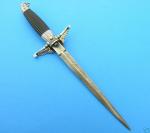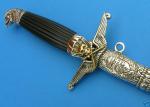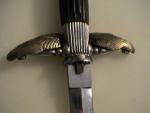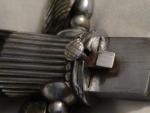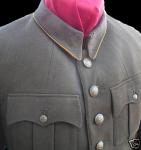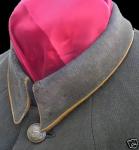-
Posts
2,660 -
Joined
-
Last visited
Content Type
Profiles
Forums
Blogs
Gallery
Events
Store
Everything posted by hunyadi
-

Hungary Hungary - WW2 Air Force Dress Daggers
hunyadi replied to hunyadi's topic in Central & Eastern European States
To get an idea of rarity and prices for these I will share my experience while living in Hungary for 7 years. In 2002 I purchased an original NCO dagger with the leather hangers for the sum of about $300. I subsequently sold it due to a financial burden to a collector in the USA for $700 in 2004. In 2008 I pruchased the officers dagger you see above for $500, but it is quite worn by many collectors standards. In all my time there I encountered only the one NCO dagger and 5 officer daggers which were undoubtily original. -
I have started a new thread about these... http://gmic.co.uk/index.php?showtopic=3511...t=0#entry328988
-

Hungary Hungary - WW2 Air Force Dress Daggers
hunyadi replied to hunyadi's topic in Central & Eastern European States
-

Hungary Hungary - WW2 Air Force Dress Daggers
hunyadi replied to hunyadi's topic in Central & Eastern European States
As these daggers ganeraly hover just below the $1000 range the industry to produce reproductions has spurend an new industry...The Royal Hungarian Paratrooper Dress Dagger - there never was such an item... -

Hungary Hungary - WW2 Air Force Dress Daggers
hunyadi replied to hunyadi's topic in Central & Eastern European States
-

Hungary Hungary - WW2 Air Force Dress Daggers
hunyadi replied to hunyadi's topic in Central & Eastern European States
Here are some images of an NCO dagger that came up for auction many many years ago and landed in the collection of an advanced Hungarian collector. Notice the finish to the eagle and the distinct variation in the push button. (cross hatching and the lower mount) According to "collector" information the NCO dagger was not introduced until 1944, but I have no way of confirming this. -

Hungary Hungary - WW2 Air Force Dress Daggers
hunyadi replied to hunyadi's topic in Central & Eastern European States
Finally for officer?s daggers, the easiest way to spot a modern reproduction is with the blade. Never in the history of the Royal Hungarian Air Force were the blades etched save for Miklos Horthy's son's dagger that was a gift to him. The blades are plain without any marks or distinguishing maker?s marks, serial numbers and never ever with engraved names. All of those are pure unadulterated fantasy... -

Hungary Hungary - WW2 Air Force Dress Daggers
hunyadi replied to hunyadi's topic in Central & Eastern European States
The second easiest way to spot a reproduction is with the release button. The release button for the officers dagger were made with a different grade of brass and therefore are of a more yellow brass than the rest of the body. Unfortunately this photo does not show it clearly with the lighting, but never accept a dagger where the color of the button on an officers dagger is the same as the rest of the body. -

Hungary Hungary - WW2 Air Force Dress Daggers
hunyadi replied to hunyadi's topic in Central & Eastern European States
As you can see from above - the eagle is quite worn on the details - this seems to be a very common trait with daggers that were used as the inner cuff would rub against the face of the eagle. The grip is made from ebony wood which was lacquered in black to protect the wood. As this one is rather worn, the grip has lost a majority of the lacquer, but still retains the details. Notice the details to the shield and the attachment of the hanger rings. These are soldered on and then finished, not cast as one piece, or screwed on as some reproductions are. Perhaps the most tell tale sign of an original dagger sheath is the minute detail to the curve. I can only say that originals can be spotted after seeing 100 fakes which do not have this feature. I have tried to enhance this unique curve with some graphics, but I realize that its not perfect. -

Hungary Hungary - WW2 Air Force Dress Daggers
hunyadi posted a topic in Central & Eastern European States
During WW2 the Royal Hungarian Air Force was relatively small compared to many of her Axis nations. I don?t have the exact numbers, but it was marginal at best. The Royal Hungarian Air Force flew mainly outdated or dismally performing aircraft from Germany and Italy for the majority of the war only to receive ME-109's, FW-190's and a handful of JU-88's during the latter stages of the war. For what they were given they performed rather admirably in the face of the Red Army's onslaught. As air power was still relatively new by WW2 the Hungarian Air Force like many other nations created a new image for its members of the Air Force. The idea was to create a uniform that gave the image of the new knights of the sky. Invariably like many nations Hungary also adopted the open collar four pocket uniform with a neck tie motif - and like Germany and other nations equipped these new knights with a striking dagger or sword. Compared to the Luftwaffe, the Royal Hungarian Air Force did produce the dress daggers (the idea of the sword was not used in Hungary) in great quantities as the officers and NCOs who would actually need one or wear one was rather miniscule. The dagger was regulated to strictly dress and parade use, not a necessary item for the majority of the war, unless you were getting commissioned, receiving an award or getting married. I would even suspect that the daggers were utilized like the Hungarian Defense Forces do today for the dress sabers - you go down to the Quartermaster sign off for the swords (which includes your liability of having to pay for them should you not return them) and after the event return the sabers. (I don?t have any documentation that this was a practice - but Hungary during WW2 had few resources so corners were cut ant every angle - so in my humble opinion this is plausible) My point with all of this is that the daggers are extremely rare, yet desirable to many. There were two forms of dress daggers. The officers dagger was finished in brass with a chromed blade while the NCOs dagger (which are infinitely more rare than the officers) had a chrome plated body with a brass finished eagle to create a stark contrast. Here is my rather worn, but still a good example as one would hope to find officers dress dagger. -
I will try to get images of my dagger and point out the features of an original to look for in the future...
-
however - by comparison - this one is a good "reproduction" which is a nice display piece - then there are the ones that go over to the realm of absolute absurdity... this one is more laughable than the WW2 Paratrooper dress daggers that many seem tripping over themselves to buy... http://cgi.ebay.com/HUNGARY-HUNGARIAN-OFFI...%3A1%7C294%3A50
-
In my opinion - No - this is not an origianl item. Daggers with numbers in the Hungary military did not begin to appear until the communist period with imported Soviet AF daggers. The details to the scabbard along with its lack of any curvature signal post war production. Though you did not show it - I would probabyl suspect that the button for the release is also made from the same grade of brass - originals are not and exhibit a variance in the patina. This dagger was probably made with the original dies which have survived the war and have been used extensively since that time. I also have seen several "113" daggers and find it hard to believe that there would have been more than one if in reality they were sequentially numbered. I would pass on this one and bide my time and wait for an original - it only took me living in Hungary for seven years to find one....
-

Austria-Hungary Magyar ?rdemrend k?z?pkeresztje
hunyadi replied to KDVR's topic in Austro-Hungarian Empire
KDVR - In my opinion I would seriously reconsider the originality of this one. Alkex K's is a nice textbook. The finish to the reverse is odd and seems a bit crude. The wreath is also very narrow and the enamel does not exhibit characteristics that I would expect after all this time. Thie pin also looks rather "clunky'. There is a big demand for these item and there have been rumors of these reproductions being manufactured. I would pass on this one in my opinion. -

Estonia Estonian WW2 Uniform
hunyadi replied to hunyadi's topic in Northern European & Baltic States
1) The seller stated that the boards were removed per German and Soviet regulations. He is apparently going to send me literature concerning this for confimation. Do you know if this is true Noor? 2) So this is a NCO / Enlisted tunic - would it have collar tabs or no? It looks like you have collar tabs on the greatcoat - but not the tunic. Do you have a web site which shows the rank system / uniforms of Estonia? Thank you for sharing your collection with us! -

Estonia Estonian WW2 Uniform
hunyadi replied to hunyadi's topic in Northern European & Baltic States
I cant wait! -
Hello All - In my quest to fill my closets with obscure itmes from rather grossly under recognized nations, I found this little gem on Ebay recently and could not pass it up. Question is that is this a "Home Guard" or National Defense tunic of the infantry which according to the seller was used by both "pro" Soviet and then later German units - hence the deletion of the shoulder boards...??? I have been trying to find any images about this tunic - but it seems that most photos depict similar tunics with a standing up collar. Can anyone confirm what it truly is (besides "Estonian" - unless it is something else?") Thanks in advance! :jumping:
-
Ebay is still the best place to buy them - our local "Militaria" shop is selling WW1 tunics for $350...another one in Idaho was selling them for over $200 in 2006. But Ebay tunics seem to hold at under 200 unless there is something special about them. I have looked at this one and have some serious questions. The wound stripe is not that common - so that makes it desireable. - But - he makes it out to be named to this Baker chap - who is not listed in the article. The Baker chap is also in a bakers company - breadmakers - well away from the front lines AND would have a loaf of bread as his privates insignia on the left arm - not the crossed rifles - so what it is - a "put together" grouping from at least two inividuals. But for an un-named Yankee Division tunic with all the patches - its not a bad buy.
-

Unknown - The Unknown Medal bar @ 1925-40
hunyadi replied to Ulsterman's topic in Southern European & Balkan States
Very interesting witht the mixture of foreign ideas, yet like the shoulder chord, some A-H elements. Yet - its still beggs the question... regardless - its a very rare and interesting photo. :jumping: -
Hi Doc - this is the Delvidek Commemorative Medal for participation in the Balkan Campaign of 1941. The ribbon is actualy 1/2 cornflower blue and 1/2 yellow.
-
1- Military Merit IIIrd Class 2- Signum Laudis in Silver 3- Signum Laudis in Bronze 4- Signum Laudis in Silver / (possibly) Bronze (Horthy era 1922 issue) 5- Hungarian WW1 Service Medal 6- Long Service Medal IInd Class 7- Long Service Medal IIIrd Class 8- Frans Joseph Commemorative Medal 1908 9 -Austrian WW1 Service Medal 10- Bulgarian WW1 Service Medal 11- Maria Knights Cross
-

HJ / Volksturm Tunic?
hunyadi replied to hunyadi's topic in Germany: Third Reich: Uniforms, Headwear, Insignia & Equipment
Nay other thoughts??? Anyone... :unsure: -
Hi Alex - The decorations are not "original" to the tunic, but they are the best bet. The EK2 was on the tunic and the loops for the EK1 are a perfect fit, thankfuly the other Hungarian orders and decorations would either be too loose or too tight - so the EK1 is the most plausable. The tunic dates from 1939 to 1944 - and there are Csendor Year Books which gave the names, ranks and awards for all of the men in the Csendor - less than 20,000 at one time. However the only year books that have surfaced in any library are the 1923 (so he would have been a lower officer) and 1944 which there is a possible match - but not 100%. At any given time there were only 8 Lt. Col in the Csendor 3 Col and one general. The loops for the medal bar are probably conservative as you can see there are loops for the ribbon bar on the tunic as well - the loops seem to hold three rows of ribbons or 12 medals... so who knows - only time and luck may tell.
-

Unknown - The Unknown Medal bar @ 1925-40
hunyadi replied to Ulsterman's topic in Southern European & Balkan States
the last word is Vagyok - or "I am" - as soldier serving as vice chairman of the association. If fading memory serves me correctly - I think this is a miner's uniform from post WW1 or for a fire brigade of the miners - but I cant be certain. For certain was the use of the rank rate on the sleves of uniforms in the short lived Hungarian Republic when in 1945 the military uniforms used this form or rank designation. If only Bela was still aroung the corner - I could ask him and he would know... :blush:




